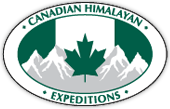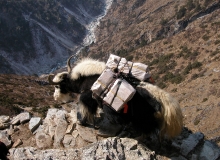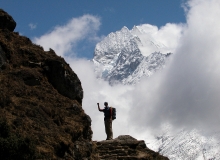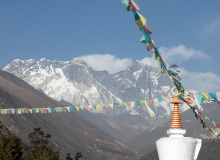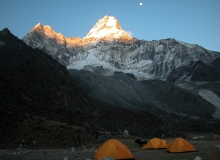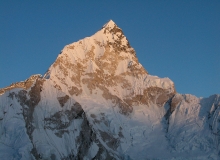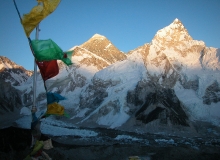Everest in Hillary’s Footsteps
Map
This spectacular 22-day trek basically follows the classic route to Mt. Everest used by the 1953 expedition which successfully placed Sir Edmund Hillary and Tenzing Norgay on the summit of the world’s highest mountain. The trek starts from Jiri, a village a few hundred kilometres east of Kathmandu. In the first seven days we cross several river valleys, passing rice paddies, farms and Rai villages of the Solu. Above Lukla we are into the Khumbu region, trekking through alpine forests, stopping in friendly Sherpa villages and visiting Buddhist monasteries.
The final leg takes us to the spectacular terrain far above the tree-line and to the base of the world’s highest mountains: Ama Dablam, Lhotse, Nuptse, and Mt. Everest. This approach to Everest is especially interesting as it involves walking at altitudes between 6,000ft (1900m) and 18,000ft (5500m) where a great variety of culture, vegetation, natural habitats, and geography is observed. A challenging but very rewarding trip!
Detailed Itinerary
1
2
3
4
5
6
7
8
9
10
11
12
13
14
15
16
17
18
19
20
21
PLEASE NOTE: Those doing the Island Peak climb will trek from Dughla to Chukhung via Dingboche on this day.
22
23
24
25
26-27
28
PLEASE NOTE: PLEASE NOTE: On adventure trips of this type, weather, local politics, transport or a multitude of other factors beyond our control can result in a change of itinerary. It is, however, very unlikely that the itinerary would be substantially altered; if alterations are necessary, the leader will decide what is the best alternative taking into consideration the best interests of the whole group. Where a change does occur, we do everything we can to minimize its effect, but we cannot be responsible for the results of changes or delays.
Synopsis
Trip Grading:

Length: 28 days total, 22-day trek
Max. Altitude: 18,400 ft / 5600m.
Begins/Ends in Kathmandu.
Land Cost: $3550 Full-service tented trek (includes everything).
Standard "Tea-house" trek is 40% less
International Airfare: Apx. $1800 (Airfare to Kathmandu)
Sep 27 - Oct 24, '20
Oct 25 - Nov 21, '20
Nov 01 - Nov 28, '20
Nov 29 - Dec 26, '20
Feb 28 – Mar 27, '21
Mar 28 – Apr 24, '21
Apr 18 - May 15, '21
Apr 25 - May 22, '21
Sep 26 - Oct 23, '21
Oct 24 - Nov 20, '21
Nov 07 - Dec 04, '21
Nov 28 - Dec 25, '21
Note: Trips start two days earlier and end one day later from North America.
Included in land cost: Airfare Lukla-Kathmandu; 22 days trekking in the Everest region including all meals and major equipment; 5 nights accommodation in Kathmandu; airport transfers for group flights; services of an experienced trip leader, cook, porters, and local guides
Single supplement: $195
Note on air ticketing: We use major international scheduled carriers for our trips, including routes that go via Europe, the Gulf states, India, or Asian cities like Bangkok, Singapore, and Hong Kong. We can explain various price and routing options for different airlines when you book and help you choose the best itinerary to fit your budget and time. However, please note that many flights into Kathmandu are heavily booked months in advance during the high season. Reserve your flight as soon as possible even if you can't confirm the trip yet.
'Full-service camping' vs. 'Tea-house' treks: THIS IS A FULL-SERVICE CAMPING TREK, WITH PRIVATE KITCHEN, FOOD, AND STAFF, COMPLETELY INDEPENDENT OF "TEA HOUSES". IF YOU WANT TO DO THIS SAME TREK STAYING AND EATING IN "TEA-HOUSES", THE COST IS ABOUT 40% LESS THAN FULL-SERVICE, BASED ON A MINIMUM OF 4 PARTICIPANTS. PLEASE INQUIRE.
You can also contact Canadian Himalayan Expeditions directly for more information.
Synopsis
Trip Grading:

Length: 28 days total, 22-day trek
Max. Altitude: 18,400 ft / 5600m.
Begins/Ends in Kathmandu.
Land Cost: $3550 Full-service tented trek (includes everything).
Standard "Tea-house" trek is 40% less
International Airfare: Apx. $1800 (Airfare to Kathmandu)
Sep 27 - Oct 24, '20
Oct 25 - Nov 21, '20
Nov 01 - Nov 28, '20
Nov 29 - Dec 26, '20
Feb 28 – Mar 27, '21
Mar 28 – Apr 24, '21
Apr 18 - May 15, '21
Apr 25 - May 22, '21
Sep 26 - Oct 23, '21
Oct 24 - Nov 20, '21
Nov 07 - Dec 04, '21
Nov 28 - Dec 25, '21
Note: Trips start two days earlier and end one day later from North America.
Included in land cost: Airfare Lukla-Kathmandu; 22 days trekking in the Everest region including all meals and major equipment; 5 nights accommodation in Kathmandu; airport transfers for group flights; services of an experienced trip leader, cook, porters, and local guides
Single supplement: $195
Note on air ticketing: We use major international scheduled carriers for our trips, including routes that go via Europe, the Gulf states, India, or Asian cities like Bangkok, Singapore, and Hong Kong. We can explain various price and routing options for different airlines when you book and help you choose the best itinerary to fit your budget and time. However, please note that many flights into Kathmandu are heavily booked months in advance during the high season. Reserve your flight as soon as possible even if you can't confirm the trip yet.
'Full-service camping' vs. 'Tea-house' treks: THIS IS A FULL-SERVICE CAMPING TREK, WITH PRIVATE KITCHEN, FOOD, AND STAFF, COMPLETELY INDEPENDENT OF "TEA HOUSES". IF YOU WANT TO DO THIS SAME TREK STAYING AND EATING IN "TEA-HOUSES", THE COST IS ABOUT 40% LESS THAN FULL-SERVICE, BASED ON A MINIMUM OF 4 PARTICIPANTS. PLEASE INQUIRE.
You can also contact Canadian Himalayan Expeditions directly for more information.
